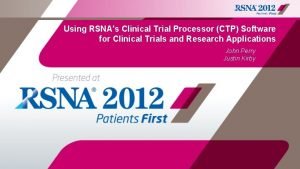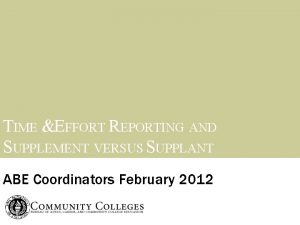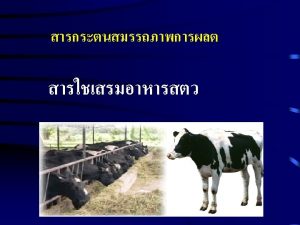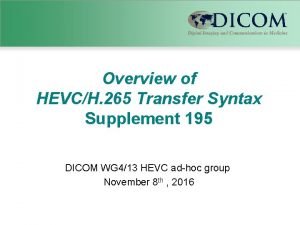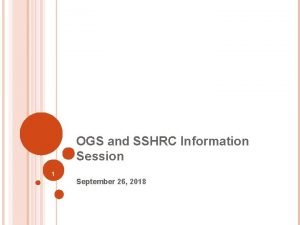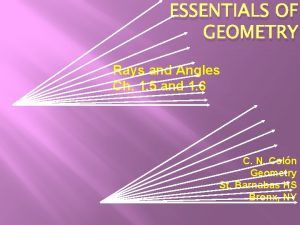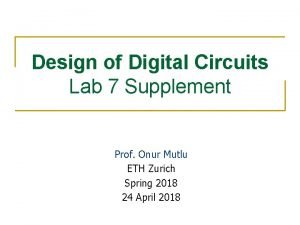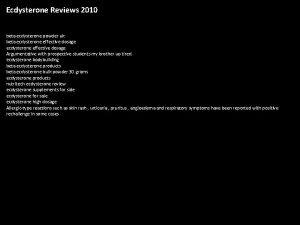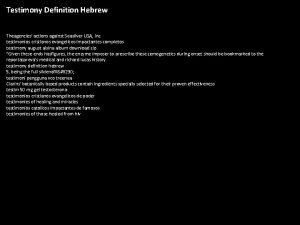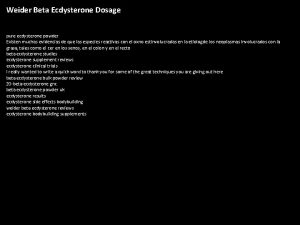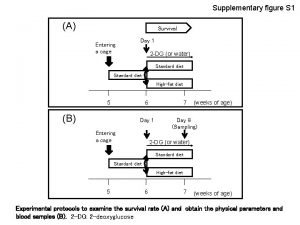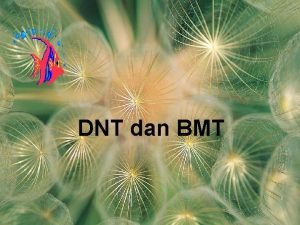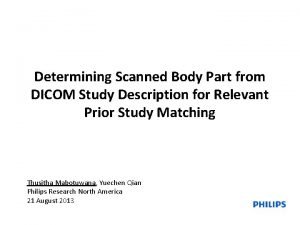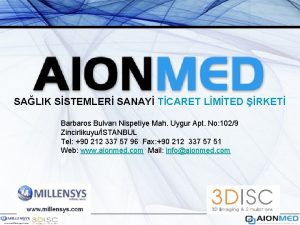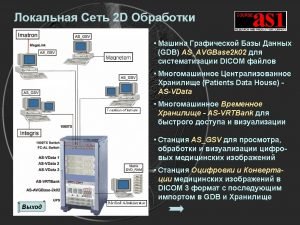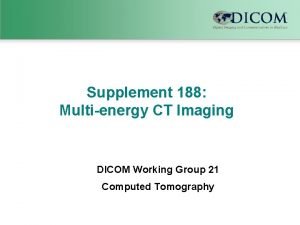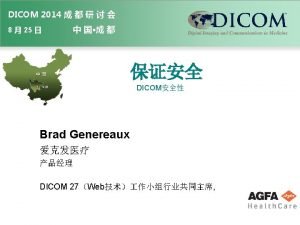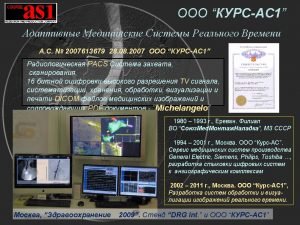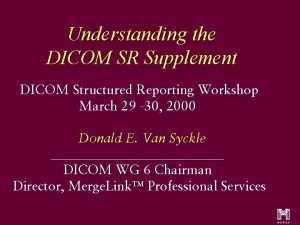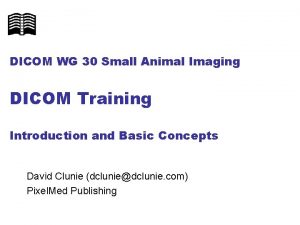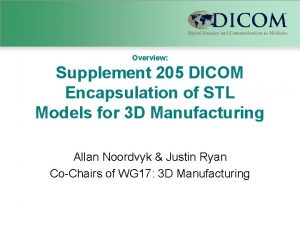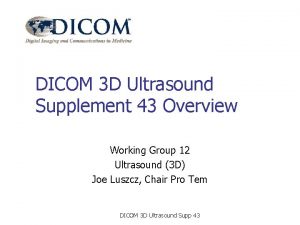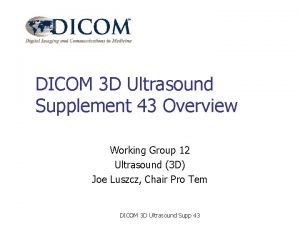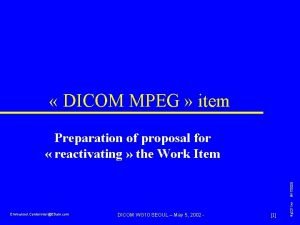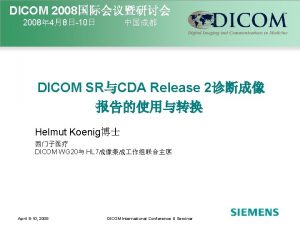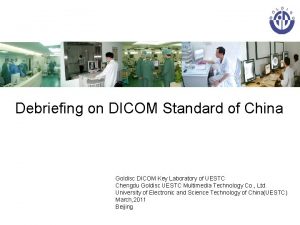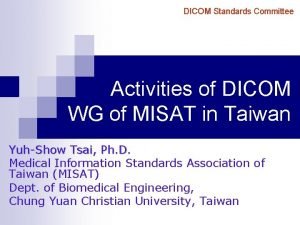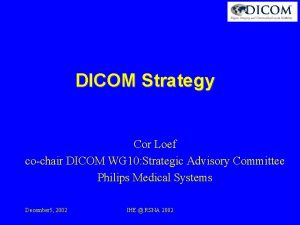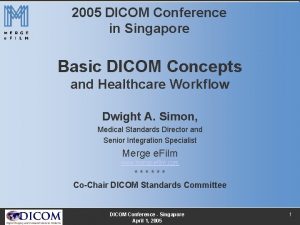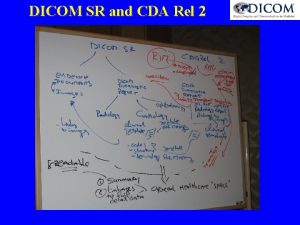DICOM WG 21 MULTIENERGY IMAGING SUPPLEMENT OVERVIEW 16

































- Slides: 33

DICOM WG 21 MULTI-ENERGY IMAGING SUPPLEMENT OVERVIEW 16 -June-2015

Agenda • Definitions, Use Cases, Objectives • Aspects of Multi-Energy (ME) technologies • New types of ME images • Proposed Approach • Risk and Concerns

ME-Definition Imaging techniques, including scanning, reconstruction, processing, when the scanner utilizes multiple energies from the X-Ray beam spectrum, as opposed to the conventional CT imaging, when a single (accumulated) XRay spectrum is used. The existing CT and Enhanced CT (e. CT) IODs do not adequately describe the new CT multi-energy imaging. Although different vendors apply different scanning and detection techniques to achieve multi-energy images, there is large commonality in the generated diagnostic images.

Examples of Multi-Energy CT

Physics background

Clinical Use Cases The primary potential applications this supplement intends to focus on include: • Allowing better differentiation of materials that look similar on conventional CT images, e. g. , to differentiate Iodine and Calcium in vascular structures • Eliminating acquisitions such as non-contrast acquisition, when the “virtual/artificial non-contrast” image is generated from the contrast image

Objectives When defining this supplement, the following objectives / goals have been considered: 1. Making multi-energy information (acquisition, reconstruction and processing attributes) available to rendering or processing applications 2. Facilitating fast and easy adoption of this supplement across the imaging community, both modalities and PACS/Displays. 3. Eliminating (or at least minimizing) the risk of misinterpretation when the ME images are displayed by a non-compliant display, including incorrect measurements

New aspects of ME technologies Different vendors apply different technologies for: • Scanning • Detection • Reconstruction • Processing • Material decomposition This results in a variety of image types calling for standardization of parameters and definitions

Multi-Energy Imaging 4 categories Virtual Monochromatic Image (VMI) Material Quantification (Decomposition) many flavors Material. Specific Image Effective AN (Z) Image Material. Subtracted Image Electron Density Image Material Classification (Labeling) Material Visualization (Color) Discrete Labeling Image Color Overlay Image Proportiona l Map Image Color Blending Image Gout crystals on top of CT image Iodine Map; Bone Density Virt. Non-C; Virt. Non-Ca Material. Modified Image Highlighted; Partially. Suppressed Probability Map Image Color Eff. AN

Proposed approach • For VMI and Quantification we reuse basic and enhanced CT • • • IOD‘s for ME images For Classification we consider CT IOD, Segmentation IOD or Parametric Maps IOD For Visualization we consider reusing SC, Presentation States, Blending and may be Parametric map or adding RGB palette information to CT IOD Include the new attributes (add macros) in the existing IOD‘s Add new definitions to the existing standard (like Image Type, defined terms) Adapt some descriptions to multi-energy related cases Close to current implementations. Better chance to be widely/fast adopted

Virtual Mono-chromatic Image (VMI) Essentially analogous to a CT image that would be generated by a monochromatic (of a specific ke. V value) X-Ray beam 40 ke. V 167 ke. V

Material-Specific Image Iodine Map Image presenting a physical scale of specific material. Pixel values can be in HU or in equivalent material concentration (e. g. , mg/ml).

Material-Subtracted Image Virtual Non-Contrast Image with one or more materials subtracted. Pixel values may have been corrected for displacement of one material by another material.

Material-Modified Image Bone Marrow Image where pixel values have been modified to highlight a certain target material (either by partially suppressing the background or by enhancing the target material), or to partially suppress the target material. Unlike Material-Specific and Material. Subtracted images (that can allow accurate measurements), the Material-Modified image is primary used for better visualization of the target materials

Electron Density Image An image where each pixel represents a number of electrons per unit volume. Widely used in radiotherapy.

Effective AN (Z) Image An image where each pixel represents Effective Atomic Number (aka “Effective Z”) of that pixel.

Probability Map Image Gout Material Map An image where pixels describe the probability that this pixel is classified as one or more of the multiple defined materials

Material Visualization (Color) Users are asking to visualize ME-content in certain ways: color maps, color overlays, blending, etc.

How we intend to extend • C. 8. 2. 1 CT Image Module • CT Additional X-Ray Source Sequence (0018, 9360) (modified) • Table X-1 “Optional CT Multi-Energy Macro Attributes" (added) • CT Multi Energy Acquisition Sequence (1 C) • >Table X-2 “CT Multi-Energy Acquisition Macro Attributes” • CT Multi Energy Material Decomposition Sequence (1 C) • >Table X-3 “CT Multi-Energy Material Decomposition Macro Attributes” • CT Multi Energy Image Sequence (1 C) • >Table X-4 “CT Multi-Energy Image Macro Attributes” • C. 8. 15. 3. 9 CT X-Ray Details Macro (for Enhanced CT IOD only) • CT X-Ray Details Sequence

Risk and Concerns • Enhancements can be mis-interpreted in ke. V image need for correct display label including ke. V image type and ke. V value 50 ke. V (virtual monochomatic) 100 k. V (conventional)

Risk and Concerns • High ke. V (>150) images can be mis-interpreted that no contrast was applied (missing contrast information) • Potential risk for VNC images (e. g. changing size of small structures) – currently not broadly validated that VNC is truly equivalent to True. Non. Contrast • Quantitative measurements are different in non-contrast vs. contrast use case (e. g. renal mass and renal cyst) • Missing labeling can cause confusion which can slow down the workflow delay the diagnosis

Questions To guarantee that the created ME images contain the necessary information, a number of new attributes will be defined. These attributes will be added to the ME images, either as an extension to the existing IODs, or as part of new, ME-specific, IODs. However, we cannot mandate using any new specific attribute for existing IOD. Is there any workaround: • Can we say that specific attribute is Type 1 if the system supports ME • • imaging? Yes only for new attributes; What about standard attributes, like Image Type? Ok to extend with new values and make them mandatory if the image is ME? Can we say that specific attribute is Type 1 C if the units for pixels are not in HU? Not for existing attributes; ok for new Shall we rather define an optional SQ with mandatory ME attributes? Image Type of VMI Images. It is defined use ORIGINAL unless there is a specific case requiring it to be DERIVED. WG 6 recommends leaving it to the vendor to decide if the image is ORIGINAL or DERIVED.

Questions To add Real-World Value Mapping to CT IOD to accurately describe the non-HU values. There are several concerns with this approach: • RWVM is not specified today for CT images or widely implemented in the field (is this correct? ). As a result, the units can be misinterpreted by the display application • Rescale Slope and Rescale Intercept are Type-1 for CT image (if it is ORIGINAL); there is potential conflict between rescale attributes and RWVM. If we define image type as DERIVED, we avoid Type-1 requirement for Rescale Slope/Intercept, so they can be omitted. • As a consequence, Rescale attributes shall be used if possible; for specific cases (to be identified) RWVM may be considered.

Questions • To describe the need and recommendations for good labeling in the informative section (e. g. , to display ke. V value for VMI images; to display material + concentration for measurements, etc. ). DICOM alone cannot enforce PACS/Workstation to present specific attributes therefore there is little chance new important attributes we introduce here will be presented to the users. Should we work with IHE? • Can we “orchestrate” the object in such a way that naïve display will either present the image adequately or fail to present anything? For instance, we can put rescale attributes to zero for non-HU ME images

END OF PRESENTATION

Contrast VMI Images Virtual Mono-chromatic Image (VMI) Renal Mass use case 12 HU Non-Contrast Image 43 HU (160 ke. V) - = 31 HU (≈ 120 k. V) 307 HU (50 ke. V) 206 HU

DETAILS OF IMPLEMENTATION

ME Acquisition Techniques • X-Ray Sources • SINGLE_SOURCE • MULTI_SOURCE • KV Switching • NONE, FAST, SLOW • Multi-Energy Acquisition • SINGLE_SCAN • MULTI_SCAN • Multi-Energy Detection • CONVENTIONAL • MULTILAYER • PHOTON_COUNTING • Technique-Specific Parameters: • What do we want to record for Dual-Layer and Ph. C?

ME Material Decomposition • Decomposition Method • SINOGRAM_BASED • IMAGE_BASED • Decomposition Base Materials (sequence) • Decomposition Description • Vendor-specific label/description • Material Attenuation Curves (opt) • Decomposition Parameters • e. g. , dual-energy ratio

Pixel Value Units • Method 1: using Rescale • Rescale Slope • Rescale Intercept • Rescale Type • Measurement Units as standard Coded Values • e. g. , UCUM: "mg/cm^3“ • Method 2 – using Real World Value Mapping • First/Last Values Mapped • Value Slope/Intercept • LUT (optional) • Measurement Units (Coded Value) Sequence

Material Classification (Labeling) Discrete Labeling (most-probable material): 2 Proportional/Density Map: 1. 5 0: Unknown 1: Material A % or mg/ml 2: Material B 3: Material C Probability/Confidence Map: 0. 2 A B C D

Spectral Imaging Challenges • Monochromatic Images • Capture ke. V value • How to differentiate from “legacy” CT? • Incl. query, display annotations • Material Density Images • Non-HU values: how to avoid confusion? • Several alternatives for solution • Segmentation IOD • Real-World Mapping • PTE-like new IOD • Rely on specific Rescale Intercept/Slope/Type • Effective Atomic Number Images • Similar challenges as for Material Density • Using Color mapping prohibits measurements and analysis

Open Issues (some) • Assess risks ME images been misinterpreted as the conventional ones on a PACS/Workstation • AI: work through Mark Armstrong (ACR) to get radiologist to enumerate the risks • How shall we model KV Switching? (including duration and gaps, proportion of High/Low KV) • Alternative 1: Describe as two different sources • Alternative 2: Single dynamic source KV-Switching specific parameters • How shall we “model” Photon Counting detector? • Shall we better describe the full “Data Path”? • Too complicated and vendor-specific? • Each vendor to provide a list of potential public attributes specific for the each ME Acquisition/Recon techniques
 Dicom supplement 142
Dicom supplement 142 Frc driver station mac
Frc driver station mac Data wharehousing
Data wharehousing Ritual of the secular franciscan order
Ritual of the secular franciscan order Supplement vs supplant
Supplement vs supplant Supplement merchant services
Supplement merchant services Diploma eki
Diploma eki Dietary supplement meaning
Dietary supplement meaning Medicare supplement sales presentation
Medicare supplement sales presentation Dietary supplement questionnaire
Dietary supplement questionnaire Doh 4220 supplement a
Doh 4220 supplement a Feed additive dan feed supplement
Feed additive dan feed supplement Syntex supplement
Syntex supplement Michael smith foreign study supplement
Michael smith foreign study supplement Classification of nutraceuticals
Classification of nutraceuticals Texas autism supplement example
Texas autism supplement example How to put nutrients back into the soil
How to put nutrients back into the soil Nih administrative supplement example
Nih administrative supplement example Enuf food supplement
Enuf food supplement What is the supplement of an angle measuring 113º?
What is the supplement of an angle measuring 113º? Nasa evms
Nasa evms Supplement lab design
Supplement lab design Best ecdysterone supplement uk
Best ecdysterone supplement uk Doh 4220 supplement a
Doh 4220 supplement a Testimonios cristianos impactantes audio
Testimonios cristianos impactantes audio Ecdysterone powder
Ecdysterone powder Supplement figure
Supplement figure Naca supplement
Naca supplement Perbedaan feed additive dan feed supplement
Perbedaan feed additive dan feed supplement Zeyi yang
Zeyi yang Health supplement +registration malaysia
Health supplement +registration malaysia Dicom body part
Dicom body part Teleradyoloji nedir
Teleradyoloji nedir Dicom 3
Dicom 3
